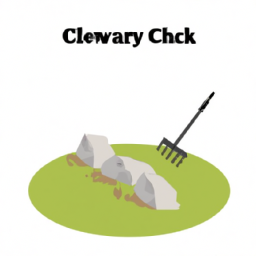How To Clean Landscaping Rocks
How To Clean Landscaping Rocks
How To Clean Landscaping Rocks
Do you have landscape rocks in your yard that need to be cleaned? Cleaning landscaping rocks is an essential maintenance task that should be done regularly, as dirt and debris can accumulate quickly. In this article, we'll explore 8-12 central themes to help you understand how to clean landscaping rocks. We'll cover a range of topics, from the rationale behind regular cleaning to the best techniques and tools to use. We'll also point out potential challenges that could arise and provide helpful resources.
Why should you clean your landscaping rocks?
The most important reason for cleaning your landscaping rocks is to maintain the aesthetic appeal of your yard. Keeping your rocks clean helps them look their best and keeps your landscape looking inviting. In addition, regular cleaning helps protect your landscape rocks against dirt, dust, and organic matter that can break down the rocks' surfaces and cause them to become dingy. Finally, cleaning landscaping rocks can help prevent the spread of weeds and other potential problems.
What type of landscape rocks should you use?
The type of landscape rocks that you use can have a significant impact on how often you'll need to clean them. Rocks like pea gravel, crushed gravel, and river stones are some of the most commonly used landscape rocks because they provide a nice finish and are relatively easy to clean. Pebbles and larger stones may require more cleaning due to their texture and surface area, while smoother rocks like slate can trap dirt and debris more easily.
What tools and cleaning supplies should you use?
In order to properly clean your landscaping rocks, you'll need some basic tools and supplies. A broom, a garden hose, and a bucket are all essential for cleaning your rocks. For more stubborn dirt and debris, you may need to use a pressure washer, a soft-bristled brush, or even a wire brush. In addition, you'll need to use cleaning supplies. For most types of rocks, water and dish soap can be enough to remove dirt. For tougher stains, you may need to use a commercial cleaner or degreaser.
Tips for cleaning your landscaping rocks
Cleaning your landscaping rocks is a relatively simple task, but there are a few tips that can help make the process easier. First, it's important to regularly clean smaller stones and pebbles so that dirt and debris don't build up. This is especially true for areas with high traffic such as pathways. Next, be sure to wear protective clothing to protect yourself from dust and debris. Finally, be sure to properly rinse your rocks after cleaning to prevent any soap or cleaner residue.
Potential challenges and solutions
Cleaning landscaping rocks can be a challenging task, so it's important to understand some of the potential problems that could arise. The most common problem is the accumulation of dirt and debris which can be difficult to remove. If you find yourself in this situation, using a pressure washer may be your best option. You'll also want to be aware of the potential hazards associated with using a pressure washer, such as damage to the rocks or even injury. In addition, it's important to use a cleaning solution that is safe for plants and the environment.
Final Word
Cleaning landscaping rocks is an important part of yard maintenance that can help keep your landscape looking its best. It's important to understand the type of rocks you're using, the tools and cleaning supplies you need, and the potential challenges you may face. With the right knowledge and a bit of effort, you can keep your landscaping rocks looking great for years to come.
Takeaways
Cleaning landscaping rocks is an important part of yard maintenance that can help keep your landscape looking its best. Be sure to use the right tools and supplies with the correct cleaning solution, and be aware of potential challenges like dirt and debris accumulation. With the right knowledge and approach, you can keep your landscaping rocks looking great for years to come.

Previous Page
Next Page
